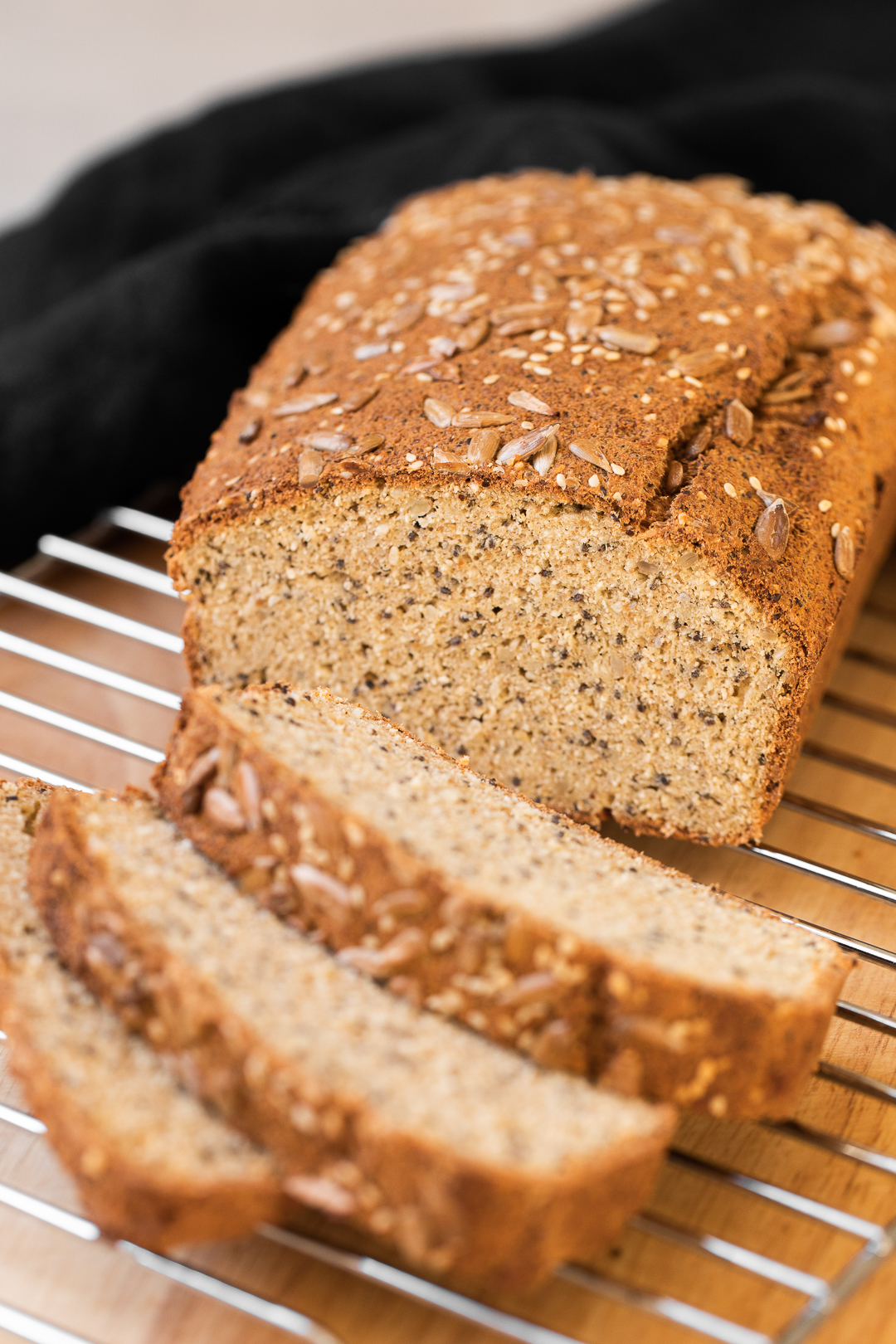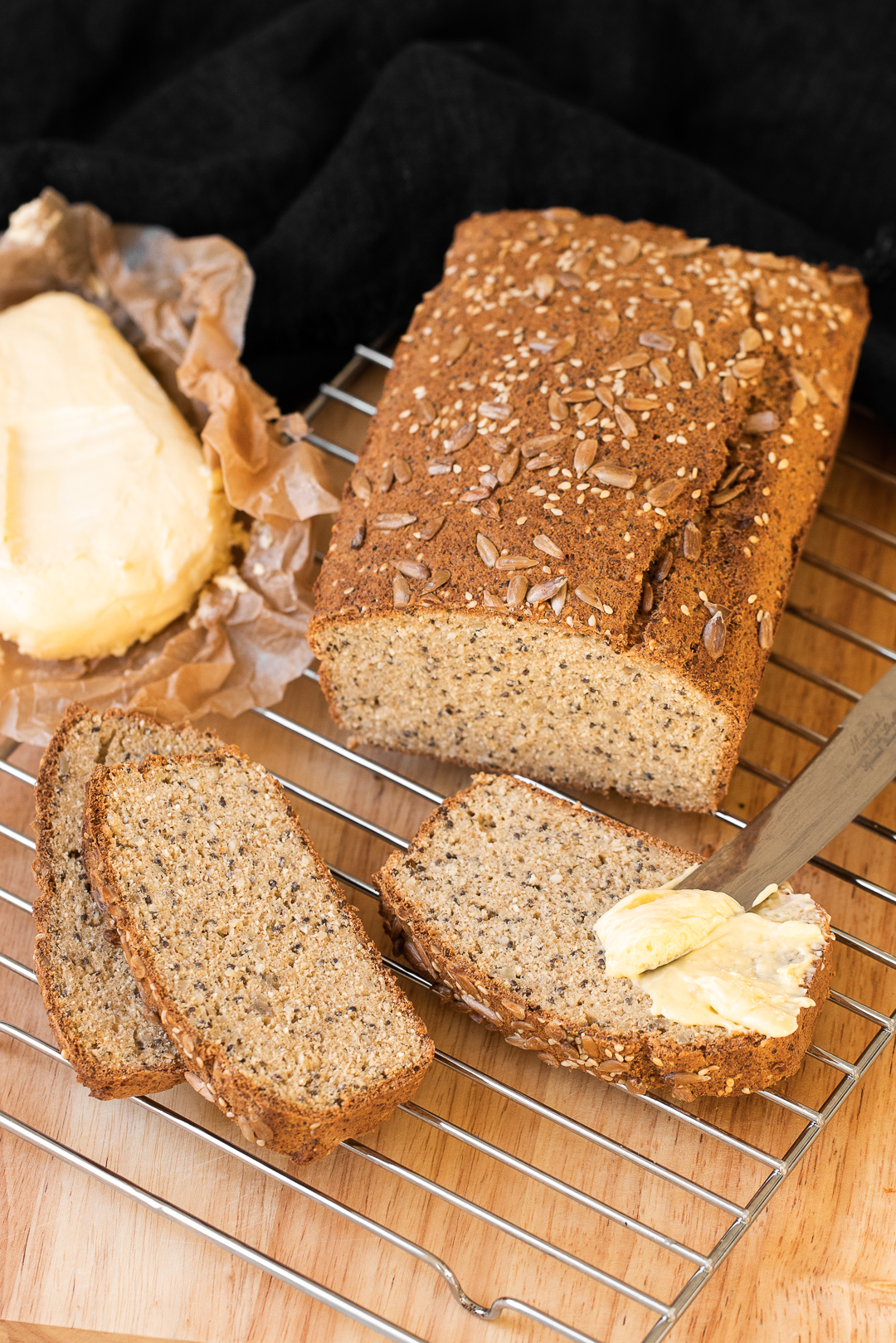Low Carb Seedy Gut Loaf
Why is this bread good for your gut? Because of the amazing fibre rich ingredients. A perk of fibre is that it acts as prebiotics for the probiotics in your gut and encourages the growth of beneficial bacteria. Prebiotic compounds also help balance harmful bacteria living in the digestive tract which ultimately helps improve overall gut health and digestion, regulate hormones, boost immunity and reduce inflammation.
Here are some of the health benefits of each fibre-rich ingredient in this bread recipe.
Psyllium husk powder
Psyllium powder soaks up water in your gut so it promotes regularity without increasing flatulence. It can be used as a one-off to ease constipation, or it can be added to your diet (like in this bread) to help promote regularity and overall digestive health. Psyllium is also a prebiotic so it also helps to encourage the growth of beneficial bacteria in our gut.
Slippery elm powder
Slippery elm works as a mucilage, acting as a thick, glue-like substance that coats your throat and digestive tract that can help with digestive issues. It causes mucous secretions, and helps to reduce inflammation and irritation associated with gastrointestinal issues or diseases such as Crohn's disease, ulcerative colitis, and irritable bowel syndrome (IBS). It has also been known to improve constipation, bloating, and diarrhea. Research also shows that slippery elm has prebiotic effects, which further supports your gut health by feeding your body’s good bacteria.
Golden flax meal
Flaxseed contains high levels of mucilage gum content, a gel-forming fibre that is water-soluble. It moves through the gastrointestinal tract undigested. Once eaten, mucilage from flaxseeds can keep food in the stomach from emptying too quickly into the small intestine, which can increase nutrient absorption and make you feel fuller for longer. Flax is also low in carbs but extremely high in both soluble and insoluble fibre, which means it also supports colon detoxification, may help with fat loss and can reduce sugar cravings. Flax can also help reduce inflammation and protect the lining of the GI tract.
Chia seeds
Almost all of the carbohydrates in chia seeds are fibre. This gives them the ability to absorb 10–12 times their weight in water. Chia seeds contain fibres that are digested by certain “good” bacteria, so adding chia to your diet could help to make positive changes to the gut microbiome.
Pumpkin seeds
Pumpkin seeds are rich in protein and fibre, both of which can slow the absorption of sugar in the bloodstream to promote better blood sugar control. Pumpkin seeds are also capable of indirectly killing tapeworms and various other forms of parasites because they contain ‘curcubitine’ – a property which can paralyse tapeworms so that they’re incapable of holding onto intestinal cells.
Apple cider vinegar
ACV has been shown to have antimicrobial, antiviral and anti-yeast and anti-fungal benefits, all helpful in supporting microbiome and overall immune balance.
This bread recipe was adapted and inspired by Wholesomeyum’s Keto Coconut Flour Bread Recipe
Makes 1 large bread loaf
Ingredients
1 cup coconut flour, sifted
1/2 cup golden flax meal (I get mine from iHerb here)
1 cup melted cultured butter (or use regular butter or ghee)
1/4 cup psyllium husk
1/4 cup sesame seeds
1/4 cup sunflower seeds
1/4 cup pumpkin seeds
1/4 cup chia seeds
2 Tbsp slippery elm powder (I get mine from iHerb here)
10 large organic eggs
2 tsp baking powder
1 Tbsp apple cider vinegar
Optional - add 1/2 - 3/4 tsp of salt if your cultured butter or butter isn’t salted
Instructions
Preheat the oven to 170C. Grease and line a bread loaf tin with baking paper.
Mix all the ingredients together in a bowl until well combined.
Place the mixture into the pre-lined loaf tin and spread it out evenly with a spatula. This mixture is thick because the chia seeds, coconut flour and psyllium will start to absorb all the moisture from the eggs and butter.
Place into the oven and bake for 50 minutes, or until golden brown and cooked through.
Remove from the oven and place the bread onto a wire rack to cool.
Serve toasted with cultured butter or ghee or avocado.







